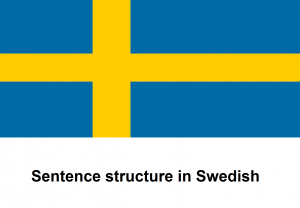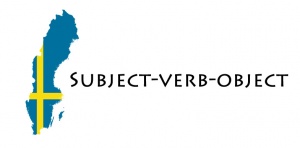Difference between revisions of "Language/Swedish/Grammar/Sentense-Structure"
(Sentence Structure in Swedish) |
|||
| Line 1: | Line 1: | ||
[[File: | [[File:Sentence Structure in Swedish .png|alt=Sentence Structure in Swedish|thumb|Sentence Structure in Swedish]] | ||
== Subject-verb-object == | . | ||
Hello everybody, | |||
In today's lesson you will learn some useful vocabulary about '''¨SENTENCE STRUCTURE¨''' in Swedish | |||
Feel free to edit this page by adding new words and expressions ! | |||
Good learning ! :) | |||
. | |||
. | |||
== '''Sentence Structure in Swedish''' == | |||
. | |||
== '''Subject-verb-object''' == | |||
Each language has a particular sentence structure and they are all built up by grammatical functions: | Each language has a particular sentence structure and they are all built up by grammatical functions: | ||
| Line 8: | Line 25: | ||
==Simple word order== | . | ||
=='''Simple word order'''== | |||
In Swedish, the sentence structure is built with SUBJECT-VERB-OBJECT. We call it "simple word order." | In Swedish, the sentence structure is built with SUBJECT-VERB-OBJECT. We call it "simple word order." | ||
===Example=== | ==='''Example'''=== | ||
Jag läser en bok (I read a book) | Jag läser en bok (I read a book) | ||
| Line 22: | Line 40: | ||
==Reversed word order== | . | ||
=='''Reversed word order'''== | |||
Swedish also has something called "reversed word order" which means that if something else than the subject comes first in a sentence, we have to move the verb to the second position. | Swedish also has something called "reversed word order" which means that if something else than the subject comes first in a sentence, we have to move the verb to the second position. | ||
===Example=== | ==='''Example'''=== | ||
*Jag läser en bok | *Jag läser en bok | ||
| Line 36: | Line 55: | ||
Do you see that "läser" and "jag" have switched places? A good tip is to think that the verb ALWAYS should be in the second position in a sentence. | Do you see that "läser" and "jag" have switched places? A good tip is to think that the verb ALWAYS should be in the second position in a sentence. | ||
==Authors== | =='''Authors'''== | ||
[http://polyglotclub.com/member/brainwashme Brainwashme] | [http://polyglotclub.com/member/brainwashme Brainwashme] | ||
| Line 47: | Line 65: | ||
|description=In this lesson you will learn how to organize a sentense in Swedish. | |description=In this lesson you will learn how to organize a sentense in Swedish. | ||
|og:image=http://polyglotclub.com/wiki/images/6/61/Subject-verb-object-Sentense-structure-Swedish.jpg | |og:image=http://polyglotclub.com/wiki/images/6/61/Subject-verb-object-Sentense-structure-Swedish.jpg | ||
}} | }}[[File:Subject-verb-object-Sentense-structure-Swedish.jpg|thumb]] | ||
[[Category: Swedish/Beginner]] | [[Category: Swedish/Beginner]] | ||
Revision as of 20:53, 5 April 2021
.
Hello everybody,
In today's lesson you will learn some useful vocabulary about ¨SENTENCE STRUCTURE¨ in Swedish
Feel free to edit this page by adding new words and expressions !
Good learning ! :)
.
.
Sentence Structure in Swedish
.
Subject-verb-object
Each language has a particular sentence structure and they are all built up by grammatical functions:
- Subject --> the person/animal/thing doing something
- Verb --> what the person/animal/thing is doing
- Object --> who/what is being affected by what the subject is doing
.
Simple word order
In Swedish, the sentence structure is built with SUBJECT-VERB-OBJECT. We call it "simple word order."
Example
Jag läser en bok (I read a book)
- To know the subject, ask yourself: Who is reading? --> "Jag", so "jag" is the subject.
- To know the verb, ask yourself: What is "jag" doing? --> "Läser", so "läser" is the verb.
- To know the object, ask yourself: What is being read? --> "En bok", so "en bok" is the object.
.
Reversed word order
Swedish also has something called "reversed word order" which means that if something else than the subject comes first in a sentence, we have to move the verb to the second position.
Example
- Jag läser en bok
(S) (V) (O)
- I dag läser jag en bok (Today I read a book)
(V) (S) (O)
Do you see that "läser" and "jag" have switched places? A good tip is to think that the verb ALWAYS should be in the second position in a sentence.
Authors

